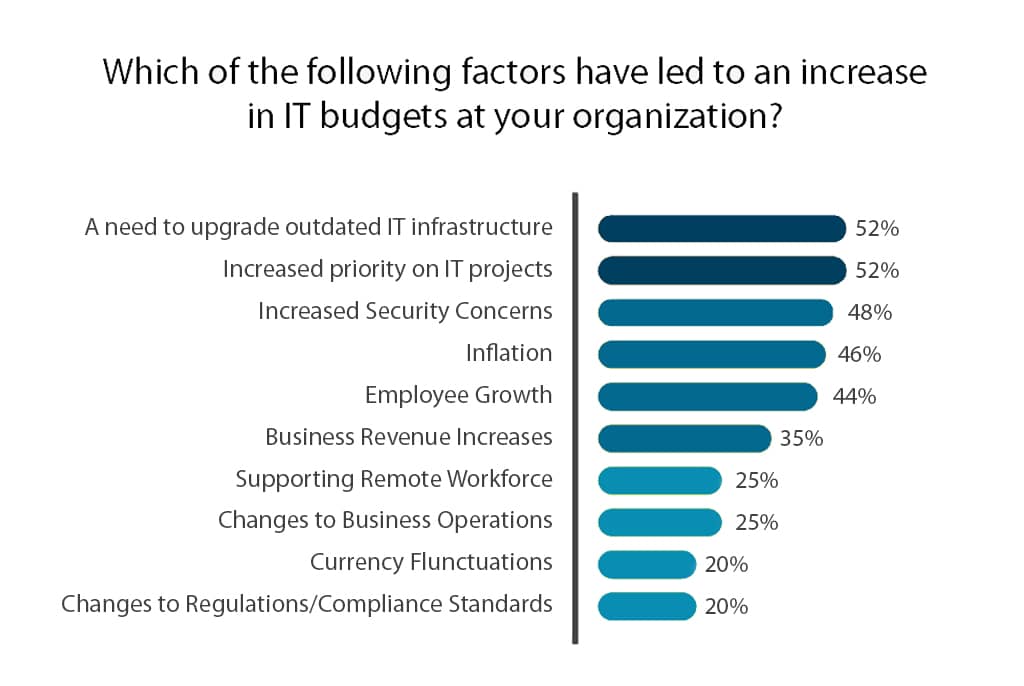Technology trends for 2024 and beyond

Editor’s note: This is the second installment of an annual 4-part series on trends impacting small and midsize businesses. Here, we study technology trends for 2024.
As we look forward to 2024, our technology narrative has been consumed by AI. However, we must remember that AI is only a component of a broader digital revolution that includes blockchain, quantum computing, nanotechnology, synthetic biology, robotics, 3D printing, AR/VR, and other emerging innovations.
Critics are concerned about the rapid acceleration of “AI singularity,” a hypothetical future event in which artificial intelligence will surpass human intelligence to a point of no return.
This narrative stokes fear that AI will destroy industries and replace jobs. Yet Harvard Business School Professor Karim Lakhani suggests that our fear should actually be humans who are leveraging AI to replace humans who are not.
In our recent piece on creative destruction, we point out that over the course of history, waves of technological innovation have created unapparelled economic value.
Technology revolutions create more jobs than they destroy. However, history has proven that the period following the rapid deployment of technological innovation arrests wages for unskilled workers (known as Engle’s Pause).
In the short term, those who control capital often benefit from technological progress.
More in this series
Part 1: Ecological trends for 2024 and beyond
Part 3: Economic trends for 2024 and beyond
Part 4: Social trends for 2024 and beyond
Business trends for 2024 and beyond [Jan 12. webinar]
Technology investment
As a result of the acceleration of AI, tech investment is shifting. According to a survey conducted by RSM, among mid-market companies:

Source: RSM
Twenty percent of respondents had experienced a data breach in the last year. (You can find a special report on cybersecurity here.) Small and midsize companies (SMBs) are reconfiguring their IT departments to meet changing priorities.

Source: Spiceworks Ziff Davis
IT departments are simultaneously defending their businesses from cyberattacks while deploying specific applications that improve the client experience and promote productivity.
Companies are moving past the promise of AI toward real-world applications they can deploy today. For example, there has been rapid adoption of chatbots that manage mundane customer service tasks.

Source: Spiceworks Ziff Davis
Leveraging AI-driven automation for competitive advantage
As 2024 approaches, businesses are poised to harness the transformative power of AI-driven automation.
Recent advancements like OpenAI’s ChatGPT have revolutionized this domain; GPT-4 stands out with its enhanced capabilities and sophisticated features.
See my prior article for a more detailed definition of General Purpose Technologies (GPTs).
Open AI has released ChatGPT Enterprise, which assures businesses accelerated data analysis, handling of intricate queries, and robust security and privacy measures.
As companies gear up for the year, the focus isn’t just on adopting these technologies, but leveraging them for tangible business outcomes and operational efficiency:
- Billing automation: Deploying AI to instantly analyze invoices, match them with purchase orders, and automatically process payments, reducing manual errors and speeding up the billing cycle. Fiserv and Klarna were two more payment companies to join Stripe in increasing their use of AI.
- Recruitment and hiring: Leveraging AI algorithms to scan and sort through thousands of resumes, matching job requirements with candidate profiles, and even automating initial interview rounds with chatbots to screen potential hires. Beamery is a talent management platform that utilizes AI to collate billions of data points to quickly identify and sort high-potential candidates.
- Customer support: Implementing AI-driven chatbots on websites and social media platforms to provide instant assistance, answer FAQs, and escalate complex queries to human agents. Sporting goods retailer Decathlon leverages a conversational AI platform called Heyday to manage such customer service requests.
- Inventory management: Utilizing AI to predict stock levels, analyze buying patterns, and optimize inventory replenishment, ensuring products are always available without overstocking.
- Sales forecasting: Applying machine learning models to historical sales data to predict future sales trends, helping businesses plan marketing and production efforts more effectively. ChatSpot pulls sales reports and sorts data for seamless prediction and analytics.
- Marketing personalization: Analyzing consumer behavior, preferences and past purchases to create personalized marketing campaigns and product recommendations, enhancing customer engagement, and increasing sales.
- Fraud detection: Employing AI to monitor and analyze transaction patterns in real time, quickly identifying and flagging suspicious activities, thus enhancing security measures. Feedzai’s data science works in real time to identify and eradicate fraud by continuously evaluating massive amounts of data and alerting customers of potential breaches.
Microsoft enters the fray with Copilot
2024 will mark the year that business professionals embed generative AI tools in their collaboration suites in such a way that improves their productivity.
One example is Microsoft Copilot, which will be featured in the Microsoft suite and will double its cost. Microsoft 365 Copilot is poised to be the core tool professionals and businesses lean on in 2024 to enhance their work and reduce mundane tasks.
Features include:
- Word: Copilot offers an initial draft to jumpstart the writing of a blog, memo or internal process document.
- PowerPoint: Presentations will be easier to create, leveraging content and design elements from past projects.
- Excel: Spreadsheets will enable better data analysis, making trend-spotting and visualization easier.
- Outlook: An overhaul of email management summarizes lengthy threads and auto-generates suggested responses.
- Teams: Instantly captures core discussions, participant insights and actionable next steps.
- Power Platform: Automation becomes more accessible, from creating chatbots to fleshing out new app ideas within minutes.
As we progress through 2024, it’s clear: AI isn’t just the future — it’s the driving force for businesses seeking to redefine efficiency and innovation.
More tech trends to look for and leverage in 2024
As we embrace the coming year, specific technological trends are making waves, reshaping industries and offering innovative solutions to age-old challenges:
Neuralink to pioneer brain-computer interfacing
Elon Musk’s Neuralink is emerging as a technological marvel. Envisioned to redefine human potential, this innovative brain-computer interface aspires to restore critical physical capabilities, including vision, motor function and speech.
But its ambition doesn’t end there; Neuralink aims to fundamentally transform our interaction with the world around us.
With FDA approval in 2023, the company is boldly advancing, recruiting individuals with severe disabilities for its pioneering human trials. The year ahead promises fascinating insights from Neuralink’s groundbreaking journey. A set of augmented reality glasses is also expected to re-enter the market in 2024.
Drones disrupting many industries
Drones are quickly integrating AI, sensors, batteries and autonomous navigation in a way that is revolutionizing the business landscape.
From swift damage assessments to immersive real estate views, drones enhance efficiency and safety across industries. Drones provide access to products and data from previously unreachable locations, without the need for labor.
A few top business use cases for commercial drones include:
- Rapid roof damage assessments, reducing the time from hours to minutes.
- Monitoring crop health and irrigation systems in agriculture.
- Providing 3D aerial views for real estate clients.
- Assisting in engineering projects, from transmission cable maintenance to road construction planning.
- Documenting special occasions like weddings from unique aerial perspectives.
- Innovating parcel delivery methods.
- Accelerating insurance claims evaluations.
Other emerging technologies in 2024
As we approach 2024, business owners must brace for transformative technological and operational process shifts:
- Green tech is leading the charge toward sustainable business practices.
- Significant tech advancements in healthcare, including AI-driven synthetic data, personalized treatments and online health advisors.
- Quantum computing is entering the practical field, accelerating complex problem-solving.
- An increased emphasis on cyber resilience to combat the escalating costs and risks of cyber threats.
- Blending real and virtual worlds through AR and VR affects consumer interactions and marketing.
- The dominance of voice search necessitates a shift in SEO strategy.
Technology can no longer be viewed as an administrative cost center. Creating technologies that enhance productivity and sustain competitive advantage are critical variables in a company’s strategic and operating plans.
Category : Economic / Future Trends
Tags: artificial intelligence, emerging technologies, Technology, technology trends affecting business
